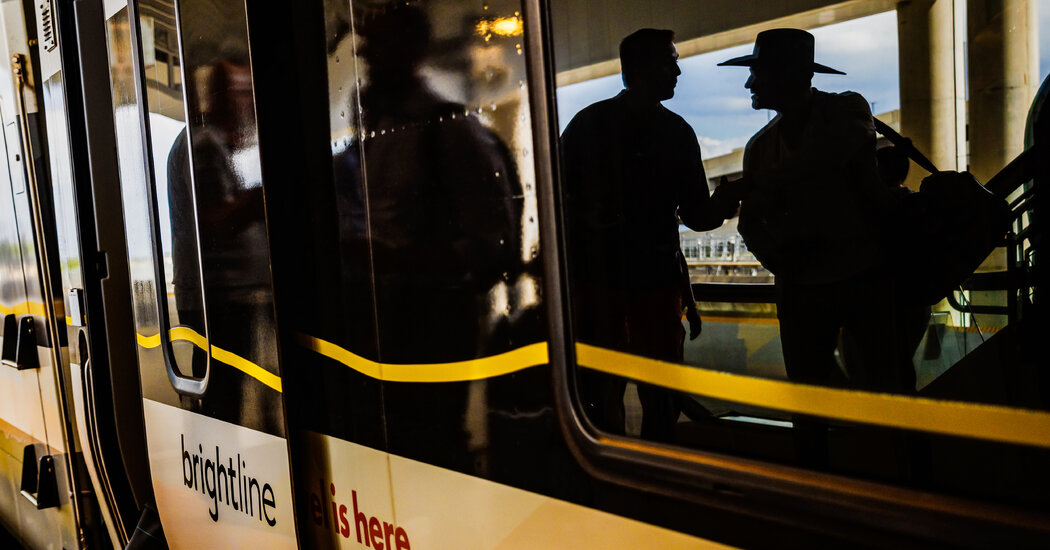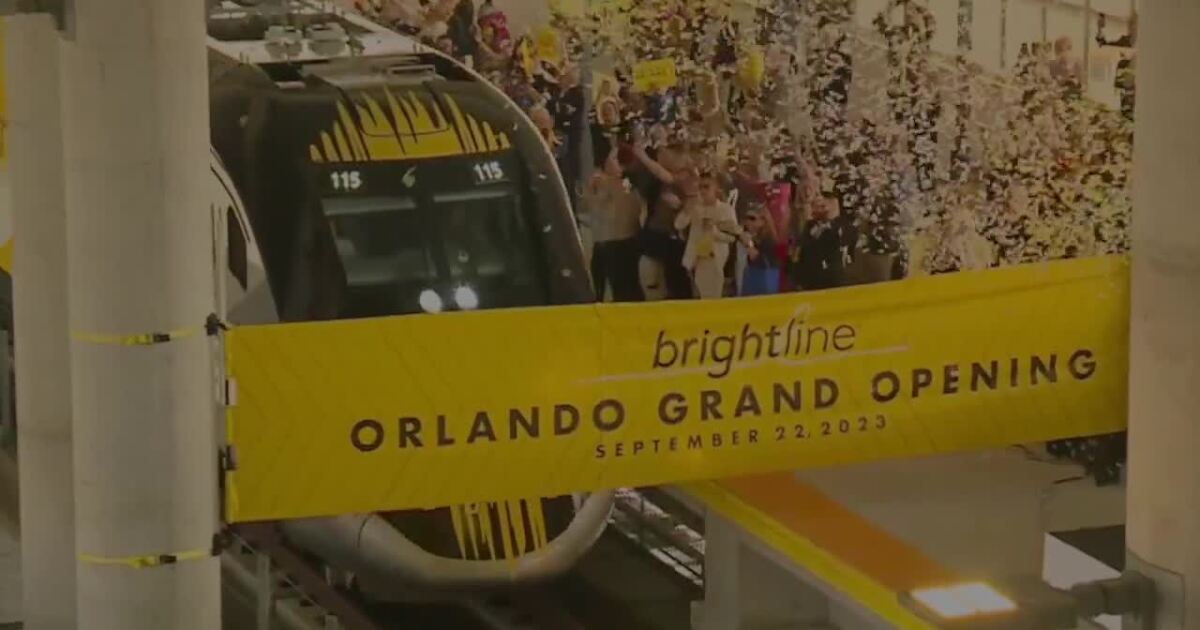Arriving Now: Fast Passenger Trains From Miami to Orlando
Brightline will make the trip in three and a half hours, with round-trip tickets starting at $158.
The fastest train in the country outside of the Northeast began service between Miami and Orlando on Friday, connecting two major cities in car-loving Florida and testing whether private passenger rail can thrive in the United States.
Brightline will make the trip in three and a half hours, about 30 minutes faster than the average car ride, reaching speeds of 125 miles per hour. Tickets from Miami to Orlando start at $158 round trip for business class and $298 for first class, with discounts for families and larger groups.
View attachment 955573
Brightline became the nation’s first private passenger rail to launch in a century when it started its service between Miami and West Palm Beach, where the company’s trains do not reach such high speeds, in 2018.
If Brightline proves profitable in Florida, it could represent a turning point for American passenger rail. The
last private intercity passenger train — the Rio Grande Zephyr, which connected Denver and Salt Lake City — shut down four decades ago. Since then, domestic rail travel has mainly been limited to Amtrak, the publicly funded but privately operated corporation, and a smattering of regional commuter and transit lines.
“This is an extraordinary development in U.S. transportation,” said Joseph P. Schwieterman, a professor at DePaul University, referring to Brightline’s rise. Mr. Schwieterman also wrote “When the Railroad Leaves Town,” a book about the decline of American railroads.
The company’s success in the state has been marred by a striking number of pedestrian fatalities on its tracks that continued even as one of its neon-colored trains made the maiden trip to Orlando on Friday morning. A train traveling southbound from West Palm Beach killed a pedestrian on the tracks while the Orlando-bound train made its way north, underscoring questions about the safety of residents near the rail line. Brightline trains have the highest death rate in the U.S., according to an ongoing
Associated Press analysis.
Ninety-eight people have been killed by Brightline trains since 2019,
according to The A.P. Most of the deaths have been suicides, drivers going through crossing gates or pedestrians running across the tracks. A spokesman for the Delray Beach Police Department said that the death on Friday appeared to be a suicide.
“We have made tremendous investments in the safety of the corridor,” P. Michael Reininger, Brightline’s chief executive, said aboard the maiden train, the Brightpink, whose passengers could see police investigators collecting evidence on the southbound tracks as it slowed in Delray Beach. “We’ve worked really hard in terms of outreach to make sure that the local communities are aware of our train service coming. We work with local law enforcement.”
Passenger rail was introduced in the United States two centuries ago and survived several economic and national crises. But rising competition from airlines and highways after World War II devastated the industry. By 1970, railroads were in such dire straits that the federal government created Amtrak to take over passenger rail, allowing the industry to focus on freight.
Amtrak has crushed the competition for travel in the Northeast Corridor that connects Washington, New York and Boston. When it launched its high-speed Acela line along that stretch in 2000, only about 37 percent of people traveling between New York and Washington made the trip by rail. That share
grew to 83 percent by the 2021 fiscal year.
More than a decade ago, Florida considered the possibility of high-speed rail between Tampa and Orlando, when the Obama administration offered $2.4 billion for the project. But then-Gov. Rick Scott, a Republican,
rejected the funds in 2011, saying the rail would be too expensive for the state to operate.
Brightline received no federal grants for construction but did get billions of dollars in investment through tax-exempt bonds. Its service could eventually stretch to Tampa and get new stations along Florida’s Atlantic Coast, Mr. Reininger said.
View attachment 955578
This year, Brightline submitted an application for a $3.75 billion federal grant to help it build an ambitious $12 billion electric high-speed railroad from Las Vegas to Southern California. Brightline says it has completed the first, most difficult phase of that project, which includes completing environmental reviews and securing right of way, most of it along a highway median.
Construction is set to begin before the end of the year, with the aim of having the train running in time for the 2028 Olympics in Los Angeles.
For the company, the true test of its business will be whether it can attract enough passengers to turn a profit.
Its Florida service is decidedly upscale: leather seats, premium lounges and gleaming stations that look more like corporate lobbies than mass transit hubs. The company sprays a citrus fragrance in its trains and stations that,
according to the perfumer, has “notes of grapefruit, orange, mandarin, lemongrass, white jasmine and musks.”
“When I think of commuter trains into New York, this is not it,” quipped Mayor Troy McDonald of Stuart, a city north of West Palm Beach.
Brightline’s service between Miami and West Palm Beach has so far appealed to both tourists and business types — especially lawyers, real estate agents and medical providers who work in several Florida cities. Now that there is service to Orlando, Patrick Goddard, the Brightline president, said he expects leisure travelers will make up 60 percent of passengers, including international travelers more comfortable with trains than rental cars.
Because Florida’s public transit is patchy at best, the company has partnered with Uber and shuttle services to get people from train stations to where they need to go, including theme parks and sporting events.
But the price is too high for many commuters, said Mark Merwitzer, policy manager for Transit Alliance Miami, a nonprofit advocacy group.
“Taxpayers should have cheaper rides than, say, someone who’s visiting from another part of the country or who’s here on vacation,” he said. “There’s so many people who could really use it as a commuter rail.”
Because of the pandemic, Brightline paused service throughout most of 2020 and 2021. It carried more than 1.2 million passengers last year but also reported a $260 million loss, driven by start-up and development costs, according to a financial disclosure. So far this year, Brightline has already carried more passengers than in 2022 and has collected over $38 million in revenue, more than double what it earned over the same period last year.
Experts credit its successful start to factors including support from local officials, lucrative development of the real estate surrounding the company’s stations, booming tourism, robust population growth and persistent highway congestion. With the Everglades to the west and the Atlantic Ocean to the east, there is also limited ability to expand existing roadways along a substantial stretch of Brightline’s route.
But perhaps the most important reason behind the company’s success so far, experts and Brightline officials said, is that it was able to establish itself mostly on an existing freight railroad, the same one that put Florida on the map more than a century ago. Because of that, Brightline was able to avoid the perilous task of cobbling together a right of way over hundreds of miles.
“That is the essential ingredient to build this,” said Wes Edens, the co-founder of Fortress Investment Group, the private equity firm that owns Brightline.
View attachment 955580
Fortress bought that freight railroad in 2007, and a few years later, Mr. Edens decided to explore starting a passenger rail company, inspired by a book about the freight railroad built by the industrialist Henry Flagler from Jacksonville to Key West. That railroad also carried passengers for a period after its founding.
Brightline believes that within a few years it will be able to serve about eight million passengers annually along the Miami-to-Orlando corridor, generating hundreds of millions of dollars in annual revenue.
On Friday, the Brightpink arriving from Miami notably sped up on the final stretch of track from Cocoa to Orlando, where trains can go fastest. Among the passengers on a later train to Miami were Pam and Jeff Landry of Tampa, who bought tickets in advance to ride Brightline on the first day of the service from Orlando.
“We love trains,” said Ms. Landry, 59, as she cuddled the couple’s year-old mini Dachshund, Sedona. “We rode them all over Europe.”
Carmen Zarhi and Jorge Andújar, tourists from Chile who spent five days in Orlando, had to make a cruise departing from South Florida. They booked their tickets to Fort Lauderdale two weeks ago, unaware that the service would not have existed had they tried to take it even a day earlier.
“We did not rent a car,” Ms. Zarhi, 30, said in Spanish. “The train was ideal.”
Brightline will make the trip in three and a half hours, with round-trip tickets starting at $158.

www.nytimes.com









